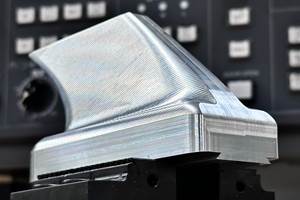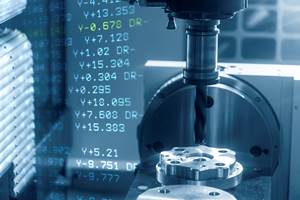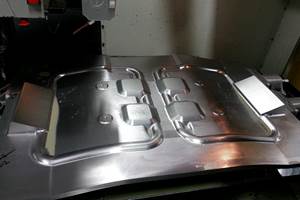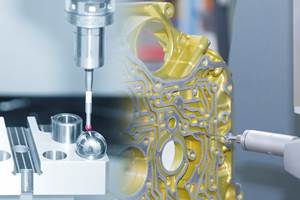Why Is Additive Manufacturing Important?
One of the important ideas showcased in this year’s Emerging Technology Center is additive manufacturing. 3D Systems, ExOne, Objet and Renishaw are all companies exhibiting in the ETC, located in Booth N-650.
Share






This part was produced by Cleveland-area plastics manufacturer Thogus. The order quantity was so low that the job was not a candidate for molding. Thogus made the parts on additive manufacturing machines instead.
One of the important ideas showcased in this year’s Emerging Technology Center is additive manufacturing. 3D Systems, ExOne, Objet and Renishaw are all companies exhibiting in the ETC, located in Booth N-650. These companies offer varied technologies, but what their systems all have in common is making parts by adding material instead of cutting it away. That is, equipment from these companies builds complex 3D forms by precisely adding material in, layer upon layer. Metal or plastic components can be made this way. Compared to traditional methods, this approach to part making might seem strange, but manufacturers in the aerospace and medical industries, among others, are already making some components additively and moving other components toward additive production. In these applications, does additive technology take the place of CNC machining?
Sometimes, yes. But in the much larger share of cases where additive manufacturing succeeds, it does so by producing forms that cannot be made practically in any other way. The promise of additive manufacturing is found not in its potential to replace machining of any existing process, but in its potential to extend the capabilities of manufacturing.
Today, the most established use of additive manufacturing is making prototypes. 3D printers can produce complex pieces in small quantities quickly for the purpose of evaluating a design. Mold makers and plastics processors frequently use additive equipment in precisely this way—to prove a part before the tooling is finalized and before full-scale production begins. However, now that additive equipment is increasingly demonstrating its effectiveness for making pieces that are precise enough and resilient enough for end-use application, additive manufacturing promises to deliver many more advantages as well.
Those advantages include:
- Design freedom. In machining, casting or molding, complexity is costly. Every complex detail has to be produced through additional tool paths or other extra steps. By comparison, part complexity in additive manufacturing adds little or no extra consideration. Forms can be created that would be impractical or unthinkable in other processes. A part can be made purely for functionality, without manufacturing-related constraints. Design engineers have only started to explore the implications of this.
- Low-quantity economy. An additive process does not require hard tooling to be produced or assembled, and it includes little in the way of setup time. As a result, there are not the typical production-related costs that often require a large production run in order to justify them. Additive processes permit very short runs—including one piece—to be printed cost-effectively.
- Material efficiency. Additive manufactured parts, particularly metal ones, still get machined. The additive cycle alone often can’t deliver the final details, dimensions and finish that a critical part demands. However, among all of the near-net-shape processes, additive manufacturing is nearest to net. The amount of material that has to be sacrificed to follow-up machining is slight.
- Predictable production. Build time in additive manufacturing is often directly predictable from the part design. This means production time can be known to a fine level of precision. As additive manufacturing spreads, manufacturers will achieve much tighter control over their production scheduling.
- Reduced assembly. This is the game-changer for many established products to which an additive production process is introduced. The complex form created through additive manufacturing can be a single piece that replaces what is currently an assembly of many pieces. That means the savings from the additive process include eliminating all of the effort that used to go into that assembly, as well as the fasteners, brazing or welding that used to be involved, and all the extra features and material that once were added to the design solely for the sake of the assembly operations.
Related Content
Custom Workholding Principles to Live By
Workholding solutions can take on infinite forms and all would be correct to some degree. Follow these tips to help optimize custom workholding solutions.
Read MoreTips for Designing CNC Programs That Help Operators
The way a G-code program is formatted directly affects the productivity of the CNC people who use them. Design CNC programs that make CNC setup people and operators’ jobs easier.
Read More4 Tips for Staying Profitable in the Face of Change
After more than 40 years in business, this shop has learned how to adapt to stay profitable.
Read MoreRethink Quality Control to Increase Productivity, Decrease Scrap
Verifying parts is essential to documenting quality, and there are a few best practices that can make the quality control process more efficient.
Read MoreRead Next
Machine Shop MBA
Making Chips and 91ÊÓƵÍøÕ¾ÎÛ are teaming up for a new podcast series called Machine Shop MBA—designed to help manufacturers measure their success against the industry’s best. Through the lens of the Top Shops benchmarking program, the series explores the KPIs that set high-performing shops apart, from machine utilization and first-pass yield to employee engagement and revenue per employee.
Read MoreAMRs Are Moving Into Manufacturing: 4 Considerations for Implementation
AMRs can provide a flexible, easy-to-use automation platform so long as manufacturers choose a suitable task and prepare their facilities.
Read More




















